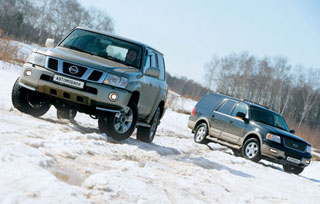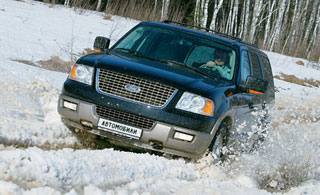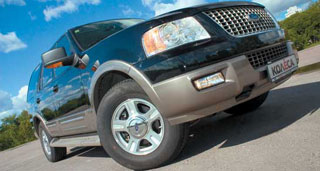Test drive Ford Expedition 2002 - 2006 SUV
Big American expedition
In America, as you know, everything is the largest. Here they sell the largest portions of Fri potatoes, show tourists the largest canyon, build the largest skyscrapers and aircraft carriers, and, of course, go to the largest SUVs. Probably because the United States is a very large country. But Russia is also rather big, so love for large forms is alive in the heart of a Russian person.From the point of view of jailing Europeans, the love of Americans is irrational for full -sized tracks and cannot cause anything but surprise. Well, who, one wonders, needs these monsters with multi -liter engines? But the Americans have their own approach to the problem, and on high -hairs, crossing the endless expanses of Arizona, Texas or Illinois, huge cars look quite organic.
In the Ford Motor production program, full -sized SUVs have been present since 1965. For thirty years they bore the same name - Bronco. But in the mid -nineties of the last century, the leadership of the concern came to the conclusion: it is time to update the lineup. Firstly, the full-size SUV of the main competitors had five doors, and not three, and, from the point of view of customers, this was preferable to dismantle a plastic kab over the back of the body. Secondly, a unique semi-dependent suspension did not justify hopes entrusted to her.
Her total mass was even more than simple, dependent, and reliability limped. In addition, the suspension turned out to be as fragile and vulnerable as the usual independent, and did not provide proper controllability and comfort. The new chassis was to be the basis of two cars at once: the next version of the F-150 pickup and full-size SUV. And in 1996, both cars saw the light: at the beginning of the year - a pickup, and in the fall - the heir to Bronco, named Expedition. During the first year, 214 524 Expedition was sold, and already in 2001, Ford proudly reported that the number of cars sold exceeded a million.
The reason for this popularity was a successful design and the optimal (at least from the point of view of an American) combination of price and consumer qualities. A huge car (the length of its body is 5 inches more than that of a couple of Tahoe/Yukon) does not seem cumbersome at all. From almost any angle, it looks firm and proportional, has a powerful staircase frame, a heroic carrying capacity (910 kg) in combination with a high level of comfort and a spacious salon.
Gamma of engines, consisting of two V8 (4.6 liters with a capacity of 215 hp and 5.4 liters with a capacity of 240 hp), provided decent dynamics (9.5 seconds to hundreds), the maximum speed is about 160 km/h and comfortable movement in cruising mode . It was no less important that both engines developed a good torque (390 and 460 nm, respectively) that, in combination with a reliable frame and a reduced gear in the handout, made a car with a magnificent tractor capable of towing a trailer weighing up to 3.5 tons. Buyers could choose a car with a drive only on the rear axle or with all -wheel drive, and the innovative Control Trac system allowed to select one of three modes: 2WD (rear -wheel drive), 4WD (all -wheel drive), 4WD Auto (automatic inclusion of all -wheel drive, all -wheel drive, When necessary). Well, if desired, you can enable 4WD Low Range, that is, a reduced gear with a ratio of 1: 2.64.
Of course, Expedition with its two hundred millimeters of the road clearance was not designed for off -road exploits, but it was quite enough to overcome the section of a broken primer. The car was distinguished by excellent smoothness, especially the option with the proposed optionally active air suspension. The suspensions of the rear and all-wheel drive versions in the basic version were slightly different. The rear axle of both versions had a spring three -winged pendant with a Panar traction, but at the front axle of the rear -wheel drive versions, springs stood as elastic elements, and at all -wheel drive - torsions.
Brakes on both bridges are disk. From other innovations, one can note the power steering with a progressive characteristic that saved the car from an old American disease - an empty and non -informative steering wheel. In 1998, the Consumer Report magazine assigned the machine the highest point for the smoothness of the move, acoustic comfort in the cabin and capacity. Experts appreciated the controllability at the hard three (the validity of the car in corners affected), but they put a unit for efficiency. But none of the buyers even hoped that the SUV with a equipped mass of 2400 kg would spend as much fuel as the Japanese low -profile.
Over the years of the release of the first -generation, and after the appearance of a fundamentally new chassis in 2003 with a completely independent suspension, it can be called that way, the car has undergone only small changes. For example, in 1999, the power of engines (4.6-liter-to 240 hp increased, and 5.4-liter-up to 260 hp). One way or another, Expedition has become one of the most successful Ford models, and his fellow, the Ford F-150 pickup, and the completely absolute leader in sales ratings in the United States.
In Russia, the fate of Ford Expedition has developed a little differently. These machines began to be imported immediately after the start of their production, and only in the all-wheel drive version and mainly in the very expensive EDDIE Bauer configuration with a powerful 5.4-liter engine. During 1997 - 1998, the popularity of Expedition grew a frantic pace, but then the crisis struck, sharply reducing the demand for expensive foreign cars, and then the government introduced customs duties ... There were new cars more attractive to wealthy Russians. As a result, the flagship of the Ford off-road line turned out to be too expensive for the emerging middle class and not sophisticated for business elites. Yes, Expedition did not, unlike his younger brother Ford Explorer or the main competitor of Chevrolet Tahoe, a common and mass machine. But the language does not turn to call it exotic. For used cars of this brand, there is not too much, but sustainable demand. It is offered to sell mainly production machines of 1996 - 1998 at a price of 17 to 20 thousand dollars.
Well, now it's time to talk about the problems that a person who decided to purchase Expections may encounter. At the same time, we will assume that this person perfectly imagines what a large American SUV is, with all its pros and cons. So we will do without general discussions about frightening rolls in corners and crazy fuel consumption when energetic driving in the city. Let's talk about the characteristic diseases of this model and begin, as usual, with the engine.
Both engines of the Triton family are exceptional reliability. Service center experts who have been working with Expections for many years were able to recall only one case when the engine required a bulkhead, and even then after a hydraulic jacket. A reliable, time -tested lower design with a chain drive of the timing mechanism does not cause any complaints. But if the engine still breaks, then problems arise of a very global nature - as a rule, non -trivial and rarely repeated. The solution to such problems costs decent money and several days of work. Although the maintenance of this motor is associated with some problems. The fact is that it is established in such a way that the back of it goes into the tunnel to the motor shield. For elementary replacement of suppositories, you have to remove the fuel rail and all the ignition coils (and the engine has eight, one at a cylinder), but still replacing candles in the rear cylinders occurs to the touch and using non -normative vocabulary.
Such a procedure is about $ 150, and the candles themselves are not too cheap (with platinum spraying of $ 15 apiece). The instruction manual recommends changing candles once every 100 thousand kilometers, but in our conditions this has to be done every 15 - 20 thousand. Often failure and ignition coils. And it's not even about the coils themselves. From our weather conditions and salt, rubber tips are tanning, and the spark begins to punch rubber and flow out the candle insulator. The coil costs about $ 100. But the problems associated with electrical wiring or injection control system are extremely rare.
When buying, you only need to check the compression - is there excessive pressure in the crankcase whether the oil throws into the air filter, and make computer diagnostics. The diagnostic system for this motor is very progressive, it sees the passes in the ignition system. The cost of such a complex of diagnostic work is about $ 70. Nozzles can be bought for $ 30, and they must be changed no more often than on other injector engines. Often, fuel pumps fail - due to the quality of our gasoline, they are wedges. Almost always in such cases, a thick brown mixture is found in the tank.
The failure of large transmission units is extremely rare. The four-speed automatic box is extremely reliable, and if you do not break through the crankcase and do not pour oil, it practically does not cause problems throughout the life of the car. But the handout is sick, but is sick mainly due to illiterate operation. The Expedition has a system of actively connected four -wheel drive Controltrac. In fact, the Borg-Warner 4416 hand-made box has its own multi-disc clutch controlled by a step electric motor. The computer reads the angular speeds of rotation of the cardans, and as soon as the difference becomes large, the electric motor compresses the clutches and introduces the handout into the engagement with the front cardan.
If you enable the 4WD Auto mode on ice or in clay, then the mechanism will begin to work too often. Friction discs do not withstand the loads and burn, and the handout is subject to bulkhead with the replacement of friction discs. The cost of such a repair is almost $ 800. In fact, in severe conditions, you need to choose a 4WD mode with a rigidly connected front bridge, and 4WD Auto should be used, for example, when risk, in case of risk, it is unexpected to jump out on a ice or on a highway with snowy estimates. Surprisingly, a step-by-step motor, which is driven by a handout, rarely fails. The same can be said about the Morse chain - it practically does not stretch. The vacuum drive of the front half -axle openly works reliably and does not cause problems. In general, the design of Expedition is made with a margin in strength and reliability.
Crosses go for a long time - at least 50 thousand km. When replacing it is better to put the original. The original crosses of the road ($ 100 - 120), but they last longer and never cause imbalance in the work of the cardans. Circules require replacement very rarely. It can be noted the high quality of anthers, which are practically not torn. In the rear bridge, a differential of high friction is installed. At times, the owners complain that the creaks are heard in it. This is usually the result of the fact that oil was filled into the bridge without special additives. It is worth changing the oil to specially designed for high -friction differentials, as all the symptoms disappear.
We categorically do not recommend buying cars with active air suspension in the secondary market. It is much more moody than the traditional option and more often fails. Ryd control sensors refuse, pillow fails. The back of the car simply sits on the chips. It becomes impossible to go on it. Treatment costs from a thousand dollars and above. As for cars with a traditional suspension, as a rule, it practically does not require surgical intervention even at the age of seven, but the front suspension may require bulkhead, especially if the previous owner used to rush to rolled tram rails and bedridden policemen.
With a run of about 50 - 60 thousand, the silent blocks of levers, ball supports and steering tips require replacement. Ball supports cost $ 44, the upper levers in the collection are $ 89, and the entire operation to redraw the suspension will cost about $ 1,400 along with spare parts. Often the owners complain of the carbon fulfill of the car in corners. The main reason for this phenomenon is not too successful shock absorbers (however, this applies to many American cars). Shock absorbers are not too expensive: the front - $ 105, the rear - $ 46. In the steering of times, the pumping pumps fail, but the frequency of this breakdown Expedition is not much different from other cars. The pump costs $ 250 - 300.
The corrosion resistance of the body is worthy of the highest rating. Expedition bodies almost do not rot, even in those places where the paint broke off after the blows and metal is visible. There are problems with the heater and air conditioning systems. The plastic of the drives of the damper breaks, and you have to change the entire system assembly. It costs about $ 2000. In winter, sometimes glasses crack. Perhaps this is due to insufficient rigidity of the twisting body. Although now many non -original glasses have appeared on sale at a price of about $ 200, and original glasses, especially with heating, of course, roads.
Mirrors refuse - usually in winter or spring. The water that falls into the mechanism freezes, the owner presses the button, the Tynk is heard! - And cook $ 350 on the mirror assembly. In elderly cars, as a rule, the rear air conditioner has already failed. The tube system passing under the machine does not withstand our salty winters. A set of tubes costs $ 2700, although recently craftsmen have learned to change them to rubber hoses. Radiators, capacitor and evaporator are regularly clogged. The car has no salon filter - probably in America the air is clean.
In general, the Ford Expedition has proven itself very well in Russian conditions, and the listed shortcomings are more than compensated by its advantages. But this is true if you know a lot about large American SUVs.
Text: Andrey Fatebin
A source: Magazine 4x4 [9/2004]








